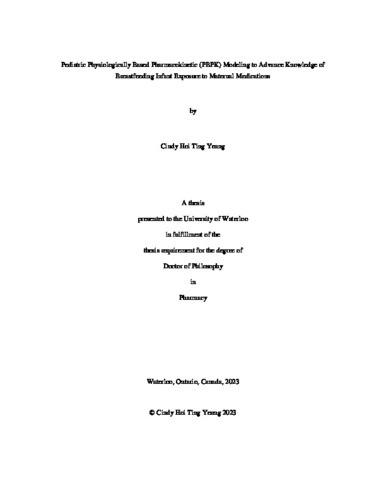| dc.description.abstract | While there are benefits of breastfeeding to the maternal-infant pair, mothers taking medication may decide not to breastfeed amid unclear risks of exposing the infant to the drug through milk. Uncertainty arises mainly due to the fact that lactating mothers and breastfeeding infants are excluded in the drug development process. In lieu of necessary data for decision making, existing resources include metrics to help estimate risk to the breastfed infant and informational resources that aim to gather all sparsely available information in databases to increase accessibility and empower healthcare providers with knowledge. Current metrics such as the relative infant dose, solely estimate the dose the infant would intake. Before better understanding the potential adverse events an infant might experience (response), a step further to understand exposure is paramount. Yet, the availability of exposure information is difficult to ascertain due to the lack of critical information on the pharmacokinetics (PK; movement of drugs in the body describing dose to exposure) of drug secretion into breast milk, and the resultant levels or exposure of the drug in infant plasma.
Physiologically based pharmacokinetic (PBPK) modeling is a promising tool to fill in the gap of scant maternal medication exposure information in breastfeeding infants. PBPK models use a simulation-based approach to model drug kinetics in an organism using knowledge of anatomy and physiology and the physicochemical properties of the drug. Pediatric PBPK models can be developed with minimal a priori data in children because these models rely on a mechanistic understanding of the disposition of the drug typically learned from rich adult data. Thus, despite the lack of available data on drug PK in infants, pediatric PBPK modeling can be used to simulate virtual breastfeeding infant populations to predict exposure given proper estimated doses.
The aim of this thesis is to use PBPK modeling to produce a novel risk metric that advances the knowledge of breastfeeding infant exposure to maternal medications. The objectives are to (1) create and apply a workflow incorporating pediatric PBPK modeling to develop the novel metric with infants breastfed from mothers taking lamotrigine, cannabidiol (CBD), and ezetimibe, (2) identify potential maternal factors that may impact concentrations of drugs in milk for incorporation into the workflow established in objective 1 for CBD, and (3) optimize the utility of the novel metric for use in clinical practice. To arrive at the first objective, a literature review was used to develop a model to describe the weight-normalized volume of intake infants typically receive. The model was then used in combination with literature (lamotrigine) or collaborator collected (CBD and ezetimibe) drug concentrations in breast milk to estimate infant daily doses. The doses were then given to virtual breastfeeding infants created through developed and evaluated pediatric PBPK models. For the second objective, linear regression was used to identify influential maternal factors on CBD milk concentrations and breastfeeding exposure predictions. Finally, qualitative interviews were conducted with healthcare providers to ascertain perspectives on the novel metric for use in practice.
Through this work, a milk intake model described weight-normalized milk intake with a maximum of 152.6 mg/kg/day at 19.7 days postnatal age. The greatest risk for breastfeeding infant exposure to maternal medications occurred during the 2-4 week postnatal age window. Pediatric PBPK models were developed for lamotrigine, CBD, and ezetimibe. For CBD, literature in vitro data informed the identity and percent contributions of metabolizing enzymes to clearance. These contributions were ascertained as UGT1A7 4%, UGT1A9 16%, UGT2B7 10%, CYP3A4 38%, CYP2C19 21%, and CYP2C9 11%. This information was used to populate the CBD pediatric PBPK model. Results from the linear regression analysis with maternal factors, including administration type, dose-frequency of use, and time after last dose of CBD, revealed that oil or pipe and joint/blunt or edible administrations produced the highest and lowest CBD concentrations in milk, respectively. Overall, the three PBPK models were able to adequately predict exposures of the drug administered in children. A novel risk metric termed the upper area under the curve ratio (UAR) was developed to describe the 95th percentile of breastfed infant AUC divided by the median therapeutic AUC of adults or children for approved indications. Across all ages (0-1 years old), the UAR ranged from 0.18-0.44, 0.00022-0.0044, and 0.0015-0.0026 for lamotrigine, CBD, and ezetimibe, respectively. From the qualitative interviews with 28 healthcare providers, six main themes emerged: (1) Current Practice Approaches, (2) Advantages of Existing Resources, (3) Disadvantages of Existing Resources, (4) Advantages of the UAR, (5) Disadvantages of the UAR, and (6) Strategies to Improve the UAR. Multiple strategies to improve the UAR, such as combining the UAR with another resource and providing guidance to interpret the UAR were attained.
The work in this thesis developed the UAR to account for the relative exposure of breastfeeding infants to maternal medications and identify potential outliers who may be most vulnerable. Through healthcare provider interviews, it was evident that the UAR confers benefits over existing metrics and can be optimized for use in practice. With the workflow applied to further drugs, the UAR has the potential to improve our understanding of drug exposures in breastfeeding infants and be used by healthcare providers in their advising. | en |

